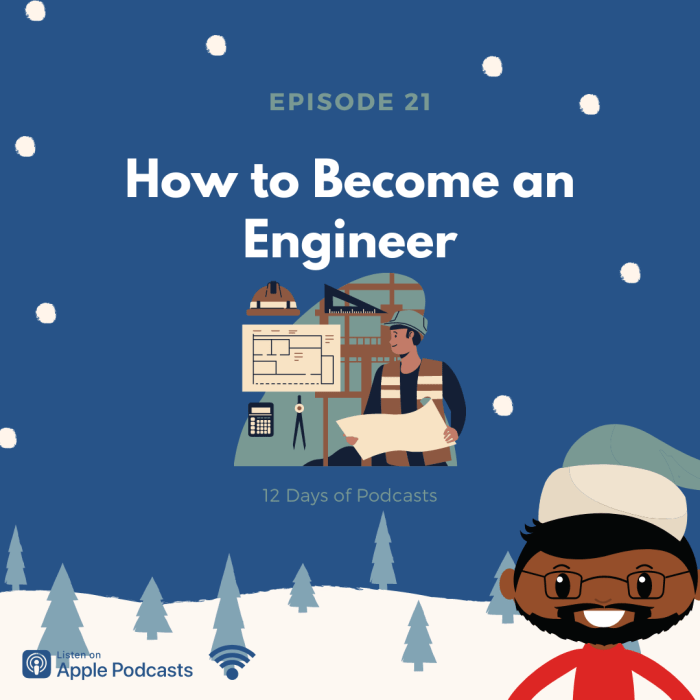
How to become an engineer? This journey begins with understanding the diverse world of engineering disciplines, from the intricate designs of civil engineers to the innovative creations of software engineers. It’s a path paved with problem-solving, critical thinking, and a thirst for knowledge. This guide breaks down the steps, from education to practical experience, to help you navigate the exciting world of engineering.
This comprehensive guide explores the different engineering disciplines, detailing the educational requirements, essential skills, and practical experience needed to succeed in this field. We’ll examine the job market trends, career paths, and the importance of continuous learning. Ultimately, this guide empowers you to chart your course toward a fulfilling engineering career.
Introduction to Engineering
Engineering is the application of scientific principles and mathematical methods to design, build, and maintain structures, machines, systems, processes, and organizations. It involves a creative problem-solving approach to address real-world challenges and improve the quality of life. Engineers use their technical expertise to innovate and develop solutions for diverse needs, from designing bridges to creating software applications.Engineers utilize a variety of tools and techniques to translate ideas into tangible outcomes.
This process often involves iterative design, testing, and refinement to ensure optimal performance and safety. The field of engineering is constantly evolving, adapting to new technologies and societal demands. It’s a dynamic and rewarding career path for those who enjoy problem-solving, innovation, and contributing to societal progress.
Branches of Engineering
Engineering encompasses a wide range of disciplines, each focusing on specific applications and technologies. These disciplines are often categorized into several major branches, each with its own unique set of skills and specializations.
- Civil Engineering: This branch focuses on the design and construction of infrastructure, including roads, bridges, buildings, and water systems. Civil engineers ensure the safety and functionality of these essential components of modern society.
- Mechanical Engineering: Mechanical engineers design and develop machines, engines, and other mechanical systems. This field encompasses a broad spectrum of applications, from automotive engineering to robotics and manufacturing.
- Electrical Engineering: Electrical engineers work with electricity, electronics, and electromagnetism. Their work encompasses power generation, transmission, and distribution, as well as the design of electronic devices and systems.
- Chemical Engineering: Chemical engineers design and operate processes for the production and transformation of chemical substances. Their work plays a crucial role in industries such as pharmaceuticals, food processing, and petroleum refining.
- Computer Engineering: Computer engineers combine computer science and electrical engineering principles to design and develop computer hardware and software. They are essential in the creation of advanced computing technologies.
Historical Context of Engineering
Engineering has a rich history, evolving alongside human ingenuity and technological advancements. Early civilizations utilized rudimentary engineering principles to construct dwellings, irrigation systems, and tools. The development of the steam engine marked a pivotal moment, ushering in the Industrial Revolution and accelerating the growth of engineering disciplines. Modern engineering is characterized by its sophisticated tools, advanced materials, and complex systems.
Importance of Problem-Solving in Engineering
Engineering is fundamentally about solving problems. Engineers are trained to analyze complex situations, identify root causes, and develop innovative solutions. The ability to think critically, creatively, and systematically is crucial for success in this field. The engineering design process often involves iterative refinement and adaptation to ensure the solution effectively addresses the problem.
Skills and Qualities for Engineering Success
A successful engineering career requires a blend of technical skills, critical thinking abilities, and interpersonal skills. Strong analytical skills, problem-solving aptitude, and a proactive approach to learning are highly valued. Furthermore, excellent communication skills are essential for engineers to effectively convey their ideas and collaborate with others. A passion for innovation and a commitment to learning are key characteristics for those pursuing engineering careers.
Engineering Disciplines Table
| Engineering Discipline | Description | Key Skills | Example Application |
|---|---|---|---|
| Civil Engineering | Design and construction of infrastructure. | Structural analysis, design, construction management | Bridge design and construction |
| Mechanical Engineering | Design and development of machines and systems. | Thermodynamics, mechanics, design, manufacturing | Automotive engine design |
| Electrical Engineering | Work with electricity, electronics, and electromagnetism. | Circuit design, signal processing, control systems | Power grid management |
| Chemical Engineering | Design and operation of chemical processes. | Chemical kinetics, thermodynamics, process design | Pharmaceutical drug synthesis |
Educational Path

Becoming an engineer involves a structured educational journey, typically starting with a bachelor’s degree. This foundational education lays the groundwork for understanding fundamental principles and developing crucial problem-solving skills. Further specialization and advanced knowledge are often pursued through master’s and doctoral degrees, ultimately leading to specialized expertise and career advancement.The educational path for engineers varies depending on the chosen discipline.
While core concepts remain consistent across many engineering fields, specific coursework and practical experiences will differ. This detailed exploration will Artikel the typical educational requirements, highlight the different types of degrees, and emphasize the importance of both theoretical knowledge and hands-on experience in shaping a successful engineering career.
So, you’re aiming to become an engineer? It takes dedication, but a strong foundation in math and science is key. Plus, staying updated on the latest tech advancements is crucial. For example, a recent push for cybersecurity leadership, as highlighted by a top cybersecurity official spurring the White House to take a more active role here , shows the importance of staying ahead of emerging threats and challenges.
Ultimately, continuous learning and a proactive approach are essential for success in any engineering field.
Typical Degree Requirements
The educational path for engineers is often structured in stages, each with increasing complexity and specialization. A bachelor’s degree forms the foundational knowledge base, while a master’s degree allows for specialization in a particular area, and a PhD provides advanced research and development opportunities. The duration and specific coursework required vary by the chosen discipline.
Types of Engineering Degrees
Different engineering degrees offer various levels of education and career opportunities. The choice of degree depends on individual career goals and aspirations.
- Bachelor’s Degree: This foundational degree typically takes four years to complete. It introduces core engineering principles, mathematical modeling, and design processes. It serves as a gateway to entry-level engineering positions and provides a strong base for future advanced studies.
- Master’s Degree: A master’s degree builds upon the foundational knowledge acquired in a bachelor’s degree. Specialization in a specific area of engineering, such as structural engineering or aerospace engineering, is often emphasized. This degree typically takes one to two years to complete.
- Doctorate (PhD) Degree: The PhD is the highest level of engineering education, focusing on original research and advanced study. It is typically a research-intensive program lasting several years. A PhD degree often leads to academic positions or research-oriented careers.
Importance of Coursework and Practical Experience
Engineering education is not solely about theoretical knowledge. Practical experience and hands-on learning are crucial components of a well-rounded engineering education. Coursework, projects, and internships provide valuable opportunities to apply learned concepts in real-world scenarios. This practical application is vital for developing problem-solving abilities, critical thinking, and teamwork skills.
So, you’re aiming to become an engineer? It’s a challenging but rewarding path. Plenty of hard work and dedication are needed, but a strong foundation in math and science is crucial. Learning about real-world applications, like how Amazon’s cloudy communications can make a bad situation worse, like this recent example , gives you a better understanding of the complexities in engineering.
Ultimately, a mix of theoretical knowledge and practical application is key to succeeding in this field.
Common Misconceptions about Engineering Education, How to become an engineer
Some common misconceptions about engineering education include believing it’s solely about math and science or that it’s a purely theoretical discipline. In reality, engineering education encompasses a broad range of skills, including communication, teamwork, and creativity. These soft skills are equally important for success in the engineering field.
Examples of Relevant Academic Courses
The specific courses required will vary depending on the chosen engineering discipline. However, some common themes appear across different specializations.
- Civil Engineering: Examples include structural analysis, fluid mechanics, geotechnical engineering, transportation engineering, and construction management.
- Mechanical Engineering: Examples include thermodynamics, mechanics of materials, dynamics, design of machines, and control systems.
- Electrical Engineering: Examples include circuit analysis, electronics, electromagnetism, signal processing, and power systems.
Table of Engineering Degree Requirements
| Degree Level | Duration | Required Courses | Career Path Options |
|---|---|---|---|
| Bachelor’s | 4 years | Calculus, Differential Equations, Physics, Chemistry, Programming, Engineering Fundamentals | Entry-level engineer, junior engineer, technician |
| Master’s | 1-2 years | Advanced mathematics, specialized engineering courses, research | Senior engineer, project manager, researcher |
| PhD | 3-7+ years | Original research, dissertation, advanced coursework | Academic research, post-doctoral research, advanced engineering roles |
Essential Skills
Engineering is a multifaceted discipline demanding a diverse range of skills beyond technical knowledge. Success in engineering hinges on the ability to approach problems systematically, think creatively, and communicate effectively. Developing these skills is crucial for navigating the complexities of engineering projects and contributing meaningfully to teams.Engineering problems often involve intricate systems and unforeseen challenges. Mastering essential skills empowers engineers to tackle these hurdles with confidence and ingenuity.
These abilities are not just beneficial in the workplace; they’re vital for continuous learning and adaptation in a rapidly evolving field.
Critical Thinking in Engineering
Critical thinking is fundamental to engineering problem-solving. It involves analyzing information objectively, identifying biases, evaluating potential solutions, and forming well-reasoned judgments. Engineers must not only understand the technical aspects of a problem but also consider the broader implications, constraints, and potential consequences. A critical mindset allows engineers to develop robust solutions that are effective, efficient, and sustainable.
Creativity and Innovation in Problem-Solving
Creativity and innovation are essential for developing novel solutions to complex engineering problems. Engineers often face situations where existing solutions are inadequate or inefficient. A creative approach allows engineers to explore alternative perspectives, generate unconventional ideas, and design innovative solutions that address specific needs. This ability to think outside the box is critical for advancing the field and creating impactful technologies.
Analytical Skills
Analytical skills are indispensable for engineers. These skills involve the ability to break down complex problems into smaller, more manageable parts, identify patterns, and draw logical conclusions. Engineers must evaluate data, identify trends, and make predictions based on their analysis. This systematic approach is critical for designing effective systems and processes.
Communication Skills
Effective communication is paramount in engineering. Engineers must be able to articulate their ideas clearly and concisely to colleagues, clients, and stakeholders. Strong communication skills facilitate collaboration, ensure understanding, and foster trust in project outcomes. Engineers must be adept at both written and oral communication, including technical reports, presentations, and project documentation.
Teamwork and Collaboration
Teamwork and collaboration are crucial aspects of engineering projects. Engineering tasks often involve diverse skill sets and perspectives, necessitating collaboration among individuals with varying backgrounds and expertise. Effective teamwork allows engineers to leverage each other’s strengths, share knowledge, and create a more robust and innovative final product. Collaboration fosters a supportive and productive environment.
Technical Skills
Proficiency in technical skills is essential for engineers. This encompasses a wide range of skills, from programming languages and software tools to specific knowledge of materials science, mechanics, and electrical engineering. Engineers must stay abreast of advancements in their chosen fields to effectively implement cutting-edge solutions. Technical skills provide the foundation for developing and implementing engineering designs.
Essential Engineering Skills Table
| Skill Category | Description | Importance | Examples |
|---|---|---|---|
| Critical Thinking | Analyzing information objectively, identifying biases, and evaluating solutions. | Essential for developing robust and effective solutions. | Identifying assumptions, evaluating risks, and considering alternative solutions. |
| Creativity & Innovation | Generating novel ideas and solutions, thinking outside the box. | Crucial for developing cutting-edge technologies. | Designing new products, optimizing existing processes, and proposing innovative solutions. |
| Analytical Skills | Breaking down complex problems, identifying patterns, and drawing conclusions. | Essential for designing effective systems and processes. | Analyzing data, identifying trends, and making predictions. |
| Communication Skills | Articulating ideas clearly and concisely, both verbally and in writing. | Facilitating collaboration and ensuring understanding. | Giving presentations, writing technical reports, and communicating with clients. |
| Teamwork & Collaboration | Working effectively with others, leveraging diverse skill sets. | Creating a supportive and productive environment. | Participating in team projects, sharing knowledge, and collaborating on solutions. |
| Technical Skills | Proficiency in relevant software, tools, and engineering principles. | Fundamental for implementing designs and solutions. | Programming languages, CAD software, specific engineering disciplines. |
Practical Experience

Bridging the gap between theoretical knowledge and real-world application is crucial for aspiring engineers. Practical experience, whether through internships, personal projects, or volunteer work, provides invaluable opportunities to apply learned concepts, develop essential skills, and gain valuable insights into the engineering profession. This hands-on experience allows you to refine your problem-solving abilities, build your network, and discover your passion within the field.Gaining practical experience is not merely about completing tasks; it’s about learning from successes and failures, understanding industry standards, and adapting to real-world constraints.
It’s an iterative process of learning, improving, and refining your skills, which directly translates to becoming a more effective and resourceful engineer.
Aspiring engineers, dive deep into the world of technical expertise! While navigating the complex landscape of STEM fields, it’s crucial to stay informed about broader societal issues. For example, the growing chorus of Google privacy complaints, often like faint voices in the wilderness, google privacy complaints faint voices in the wilderness , highlight the importance of ethical considerations in technology.
Ultimately, becoming a well-rounded engineer involves more than just mastering technical skills; it also means understanding the broader societal impact of your work. So, keep learning and keep questioning!
Internships and Apprenticeships
Internships and apprenticeships offer invaluable opportunities to work alongside experienced professionals, gain first-hand knowledge of specific engineering disciplines, and develop professional networking skills. They provide a direct pathway to practical experience, allowing you to apply theoretical knowledge in a real-world setting. This exposure is critical in understanding the nuances of the engineering profession and tailoring your skills to industry needs.
Internships and apprenticeships often lead to full-time employment opportunities, demonstrating the value employers place on practical experience.
Types of Practical Experiences
Practical experiences extend beyond internships and apprenticeships. They include a diverse range of opportunities that allow for skill development. Volunteer work, personal projects, and extracurricular activities are valuable additions to your experience portfolio. Each provides a unique perspective and opportunity to refine skills, showcase your dedication, and learn new techniques.
Volunteer Engineering Work
Volunteering in engineering-related projects allows you to apply your knowledge to real-world challenges, often in underserved communities. This experience fosters a sense of social responsibility and builds teamwork and communication skills, often within diverse teams. Examples include assisting in community infrastructure projects, developing solutions for sustainable energy initiatives, or contributing to humanitarian engineering endeavors.
Personal Projects
Personal projects provide an avenue to explore engineering concepts independently, develop problem-solving skills, and build your portfolio. These projects allow you to focus on areas of interest and demonstrate initiative and creativity. Projects can range from designing and building a simple machine to developing a software application, or even creating a prototype for a product. They demonstrate initiative and a commitment to learning and developing your skills.
Leveraging Extracurricular Activities
Extracurricular activities can be powerful tools for developing valuable skills and building a strong engineering profile. Engaging in clubs related to engineering, robotics, or design can provide opportunities for collaboration, leadership, and problem-solving. Participating in competitions, such as robotics or design challenges, can help build crucial skills, enhance your confidence, and expose you to a competitive environment.
Building a Strong Portfolio
A strong portfolio is essential for showcasing your abilities and experience to potential employers. It should effectively demonstrate your skills, knowledge, and accomplishments in a professional manner. The portfolio should present your projects in a structured and visually appealing format, including detailed descriptions, specifications, and any relevant data. It’s an opportunity to demonstrate your creativity and problem-solving skills in a concrete way.
| Experience Type | Description | Benefits | Tips for Obtaining |
|---|---|---|---|
| Internships/Apprenticeships | Gain practical experience in a professional setting | Develop skills, network, gain industry knowledge | Research companies, tailor applications, demonstrate interest |
| Volunteer Work | Apply engineering skills to community projects | Develop teamwork, communication, and social responsibility skills | Identify relevant organizations, showcase your skills |
| Personal Projects | Explore engineering concepts independently | Develop problem-solving skills, demonstrate initiative | Identify projects of interest, document progress |
| Extracurricular Activities | Participate in clubs, competitions, and other related activities | Develop collaboration, leadership, and problem-solving skills | Identify clubs/activities of interest, actively participate |
Career Development
Navigating the engineering landscape requires more than just technical expertise. A strong understanding of career paths, market trends, and professional development is crucial for long-term success. This section explores essential aspects of career advancement, empowering engineers to proactively shape their future.Successful engineers are adaptable, constantly learning, and adept at leveraging their skills in a dynamic job market. Building a robust professional network, developing a strong online presence, and embracing continuous learning are key strategies for navigating this journey.
Job Market Trends in Engineering Disciplines
The engineering job market is diverse and dynamic, with varying trends across disciplines. Software engineering, for instance, consistently shows high demand, driven by the increasing reliance on technology in all sectors. Civil and mechanical engineering continue to be crucial for infrastructure development and manufacturing, though specific projects and employment levels can fluctuate. Environmental engineering is gaining prominence as environmental concerns become more urgent, creating new career opportunities.
This trend is further supported by the rising need for sustainable solutions.
Career Paths within an Engineering Field
Engineers can choose diverse career paths within a specific discipline. A software engineer might specialize in web development, mobile app development, or data science. A mechanical engineer could focus on automotive design, robotics, or aerospace engineering. Understanding these specialization options allows engineers to tailor their skills and knowledge for targeted roles. Such specialized roles are increasingly sought after, reflecting the complexity of modern engineering challenges.
Networking and Professional Development
Cultivating a strong professional network is invaluable. Attending industry events, joining professional organizations, and connecting with mentors and peers through online platforms can significantly enhance career prospects. Active participation in industry forums and conferences provides valuable opportunities to learn from experts, stay updated on industry trends, and forge connections. These interactions are often pivotal in gaining insights and leading to potential employment opportunities.
Creating a Professional Online Presence
A strong online presence is critical for visibility and credibility. Creating a professional website or LinkedIn profile that showcases skills, projects, and experiences is crucial. A well-maintained online profile demonstrates expertise and professionalism. Sharing relevant articles, blogs, or technical insights further positions the engineer as a thought leader.
Continuous Learning in Engineering
The engineering field is constantly evolving. Continuous learning through workshops, online courses, and certifications is essential to stay relevant and competitive. Staying abreast of new technologies, methodologies, and best practices through continuous learning ensures adaptability and opens doors to higher-level roles. Engineers who embrace continuous learning are better equipped to solve complex problems and drive innovation.
Certifications and Licenses
Professional certifications and licenses can significantly enhance an engineer’s credibility and earning potential. These credentials often demonstrate specialized knowledge and competency in specific areas, making the engineer more attractive to employers. Certifications also signify a commitment to continuous learning and a deeper understanding of the profession. This commitment to professional growth is often highly valued.
Career Path Analysis
| Career Path | Description | Skills Needed | Advancement Opportunities |
|---|---|---|---|
| Software Engineer | Develop and maintain software applications. | Programming, problem-solving, teamwork, communication | Senior Software Engineer, Lead Engineer, Architect |
| Civil Engineer | Design and manage infrastructure projects. | Engineering design, project management, construction, surveying | Project Manager, Senior Civil Engineer, Engineering Consultant |
| Mechanical Engineer | Design, develop, and test mechanical systems. | Mechanical design, CAD, analysis, prototyping | Senior Mechanical Engineer, Design Engineer, Manufacturing Engineer |
| Environmental Engineer | Develop solutions for environmental problems. | Environmental science, engineering design, policy, sustainability | Environmental Consultant, Project Manager, Regulatory Affairs Specialist |
Tools and Resources
Mastering engineering requires more than just theoretical knowledge; it necessitates practical application through diverse tools and resources. Staying abreast of technological advancements and leveraging reliable materials are crucial for success in this dynamic field. This section details essential software, online platforms, and professional networks that aid in problem-solving, research, and career development.
Engineering Software and Tools
A wide array of software tools are indispensable for engineers. From CAD (Computer-Aided Design) programs for creating precise models to simulation software for testing and optimizing designs, these tools accelerate the design process and reduce errors. Familiarity with these tools enhances problem-solving and design capabilities.
- Computer-Aided Design (CAD) Software: Software like AutoCAD, SolidWorks, and Revit are crucial for 2D and 3D modeling, drafting, and design visualization. These programs allow engineers to create detailed blueprints and virtual prototypes, enabling precise communication and efficient collaboration within design teams.
- Simulation Software: Tools like ANSYS, COMSOL, and MATLAB are used to simulate physical phenomena, allowing engineers to test designs under various conditions without costly physical prototypes. This accelerates the design process and helps in identifying potential problems early on.
- Programming Languages: Languages like Python, C++, and Java are fundamental for automating tasks, developing algorithms, and creating custom applications. This is vital for modern engineering projects requiring sophisticated computational analysis.
- Specialized Engineering Software: Various specialized software exists for specific engineering disciplines, such as structural analysis software for civil engineers, circuit simulation software for electrical engineers, and fluid dynamics software for mechanical engineers. These tools are crucial for accurate analysis and design within each specialized area.
Online Resources for Engineers
The internet provides a wealth of information and resources for engineers. Online forums, tutorials, and databases offer a comprehensive knowledge base, fostering collaboration and skill development.
- Online Learning Platforms: Platforms like Coursera, edX, and Udacity offer courses and specializations in various engineering disciplines. These platforms enable engineers to stay updated on the latest advancements and enhance their expertise.
- Engineering Databases and Journals: Numerous online databases, such as IEEE Xplore and ScienceDirect, provide access to peer-reviewed journals and technical papers. This access allows engineers to stay informed about cutting-edge research and advancements in their field.
- Engineering Forums and Communities: Online forums and communities offer a platform for engineers to share knowledge, ask questions, and solve problems collaboratively. These platforms foster a sense of community and facilitate learning from experienced professionals.
Staying Updated with Technological Advancements
Technological advancements are rapidly transforming the engineering landscape. Continuous learning and adaptation are essential for engineers to remain relevant and effective in their roles. Staying informed about new technologies and methodologies helps engineers tackle complex challenges.
- Following Industry News and Trends: Regularly reviewing industry publications, attending conferences, and participating in online discussions allows engineers to stay updated on the latest advancements in technology and best practices.
- Attending Workshops and Seminars: Industry-specific workshops and seminars provide valuable insights and training on new tools and technologies. This direct exposure to new knowledge and skill development accelerates the learning process.
Importance of Reliable Reference Materials
Reliable reference materials are essential for engineers to verify data, understand complex concepts, and ensure accuracy in their work. These resources are a critical part of the engineering process.
- Textbooks and Handbooks: Comprehensive textbooks and handbooks provide detailed information on various engineering disciplines. These resources are valuable for understanding fundamental principles and applying them to practical problems.
- Standards and Codes: Standards and codes, such as those published by organizations like ASTM and ASME, provide guidelines and specifications for engineering designs. Adhering to these standards ensures safety, quality, and reliability in engineering projects.
Professional Organizations
Professional engineering organizations play a vital role in fostering a strong engineering community. They provide networking opportunities, professional development, and access to industry standards.
- Membership Benefits: Professional organizations often offer valuable benefits to members, such as access to journals, conferences, and networking opportunities. These benefits support professional growth and development.
- Networking Opportunities: Professional organizations provide platforms for engineers to connect with peers, mentors, and industry leaders. This interaction fosters collaboration and knowledge sharing.
Essential Tools and Resources Table
| Category | Tool/Resource | Description | Use Cases |
|---|---|---|---|
| Software | AutoCAD | 2D and 3D design and drafting software | Architectural design, mechanical design, civil engineering drawings |
| Software | ANSYS | Finite element analysis (FEA) software | Structural analysis, thermal analysis, fluid flow simulation |
| Online Resources | Coursera | Online learning platform | Taking courses, acquiring new skills, professional development |
| Professional Organizations | ASME | American Society of Mechanical Engineers | Networking, professional development, industry standards |
Troubleshooting and Problem Solving: How To Become An Engineer
Engineering thrives on problem-solving. Troubleshooting is an integral part of the engineering process, requiring methodical approaches to identify root causes and implement effective solutions. A strong understanding of troubleshooting methodologies, coupled with practical experience and a proactive risk assessment, is crucial for successful engineering endeavors.Effective troubleshooting involves more than just fixing symptoms. It necessitates a deep understanding of the underlying principles and mechanisms involved in a system or process.
This understanding allows engineers to anticipate potential problems, prevent their occurrence, and develop robust solutions that can withstand future challenges. It’s a process of continuous learning and refinement.
Troubleshooting Methodologies
Various methodologies exist for troubleshooting, each with its own strengths and weaknesses. A common approach is the “divide and conquer” method, breaking down a complex problem into smaller, more manageable parts. Another popular method is the “5 Whys,” a technique that iteratively asks “why” to uncover the root cause of a problem. Understanding the differences in approaches enables engineers to choose the most suitable methodology for a particular situation.
Techniques for Identifying and Resolving Engineering Problems
Identifying the root cause of an engineering problem is crucial. Tools like flowcharts and fault trees can visually represent the system and potential failure points, aiding in the systematic analysis. Analyzing data logs and sensor readings is essential for identifying patterns and anomalies that may indicate the source of the problem. Once the root cause is determined, engineers need to develop and implement a solution that effectively addresses the issue.
Examples of Complex Engineering Challenges and Solutions
The design and implementation of large-scale infrastructure projects, such as bridges or dams, often present significant engineering challenges. These projects require meticulous planning, rigorous testing, and innovative solutions to ensure safety and functionality. Consider the construction of the Hoover Dam, which presented numerous challenges related to material science, structural stability, and environmental impact. The solution involved the development of new concrete formulations, advanced structural analysis techniques, and environmental mitigation strategies.
Similarly, designing efficient and sustainable transportation systems is another complex challenge, requiring engineers to balance performance, cost, and environmental impact. Modern approaches often include extensive simulations and optimization to achieve these goals.
Importance of Risk Assessment in Engineering
Risk assessment is a vital part of engineering design. It involves identifying potential risks, analyzing their likelihood and potential impact, and developing mitigation strategies. A well-defined risk assessment process helps engineers to anticipate and address potential issues before they escalate into significant problems. For example, in the design of a nuclear power plant, a thorough risk assessment is essential to identify and mitigate potential hazards associated with radiation leaks or equipment failures.
By evaluating potential risks and implementing mitigation strategies, engineers can improve safety and reliability in their designs.
Role of Simulation in Engineering Design
Simulation plays a critical role in modern engineering design. It allows engineers to test and evaluate different design options, predict system behavior under various conditions, and identify potential issues before physical prototypes are built. Computational fluid dynamics (CFD) simulations, for example, are used to analyze airflow patterns around aircraft wings or to model the flow of fluids in pipelines.
Simulation can significantly reduce the time and cost associated with physical testing, enabling engineers to optimize designs more efficiently.
Case Study: The Tacoma Narrows Bridge Collapse
“The collapse of the Tacoma Narrows Bridge in 1940 served as a stark reminder of the importance of understanding aerodynamic forces and the potential for unexpected structural behavior. Engineers were initially unaware of the dynamic instability that could arise from the interaction of wind and the bridge’s structure, resulting in a catastrophic failure. This event spurred research and development in structural analysis and wind engineering, leading to more robust design standards for bridges and other structures.”
Final Conclusion
So, you’re ready to embark on the journey of becoming an engineer? This guide has provided a roadmap, highlighting the critical steps from education and skill development to practical experience and career advancement. Remember, continuous learning and adaptability are key to navigating the ever-evolving landscape of engineering. Now, go forth and build!






